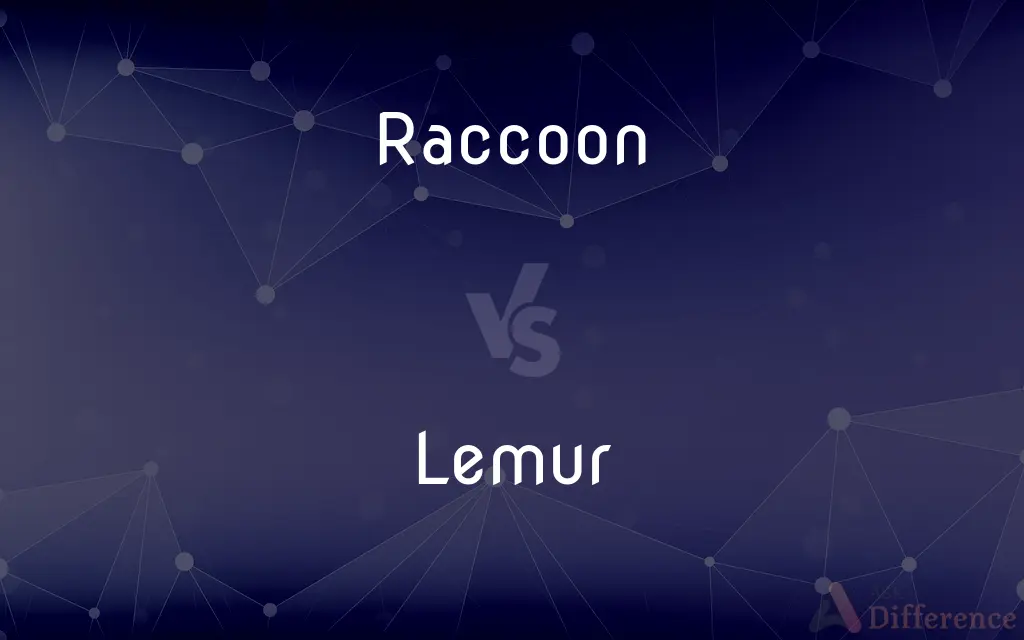Raccoon vs. Lemur — What's the Difference?
Edited by Tayyaba Rehman — By Fiza Rafique — Updated on November 5, 2023
Raccoons are North American mammals known for their masked faces, while lemurs are native to Madagascar and are a type of primate.

Difference Between Raccoon and Lemur
Table of Contents
ADVERTISEMENT
Key Differences
Raccoons are medium-sized mammals found predominantly in North America. They are known for their distinct facial masks and ringed tails. Lemurs, in contrast, are a diverse group of primates unique to the island of Madagascar. Their features vary widely, from the tiny mouse lemur to the larger indri, with no facial masks like raccoons.
While raccoons are opportunistic omnivores, often spotted rummaging through trash in urban areas, lemurs have more specialized diets that can range from fruit and leaves to insects, depending on the species. Raccoons are known for their dexterity, using their sensitive front paws to open containers and climb, whereas lemurs are more adapted to an arboreal lifestyle, with many species having long, bushy tails for balance.
Raccoons have adapted well to human environments, which has allowed their populations to thrive in diverse habitats, including cities. Lemurs, however, are forest dwellers whose habitats are under threat due to deforestation and human encroachment, making some species critically endangered.
Social structures also differ significantly, with raccoons being more solitary, only coming together during the mating season. Lemurs, on the other hand, often live in social groups, with the size and structure of these groups varying widely among different lemur species.
Raccoons experience a wide range of temperatures in their habitats, leading to a thick underfur that insulates against cold winters. In contrast, lemurs, being indigenous to a tropical island, have adapted to a warm climate and have less need for such insulation.
ADVERTISEMENT
Comparison Chart
Native Habitat
North America
Madagascar
Diet
Omnivorous, very adaptable
Primarily herbivorous, some omnivorous
Social Structure
Solitary or small family groups
Social, living in groups
Conservation Status
Least concern for most species
Many species are endangered
Physical Adaptation
Masked face, ringed tail, thick winter fur
Varied, often with long tails, less fur density
Compare with Definitions
Raccoon
A raccoon is a nocturnal omnivore with a distinctive facial mask.
The raccoon foraged for food in the campsite.
Lemur
Lemurs typically live in social groups within the forest.
The lemur group basked in the sun together.
Raccoon
Raccoons are often found in urban areas due to their ability to scavenge.
Raccoons rummaging through trash are a common sight in the city.
Lemur
Lemurs have a diet that includes fruit, leaves, and insects.
The lemur foraged for fruits among the branches.
Raccoon
Although raccoons are mostly solitary, they may gather in communal areas for feeding.
A solitary raccoon crossed the backyard at dusk.
Lemur
A lemur is an arboreal primate indigenous to Madagascar.
The lemur leaped from tree to tree.
Raccoon
Raccoons have nimble paws and are known for their foraging habits.
The raccoon used its paws to open the garbage bin.
Lemur
Many lemur species are endangered due to habitat loss.
Conservation efforts are crucial for the survival of lemurs.
Raccoon
The raccoon ( or US: (listen), Procyon lotor), sometimes called the common raccoon to distinguish it from other species, is a medium-sized mammal native to North America. It is the largest of the procyonid family, having a body length of 40 to 70 cm (16 to 28 in), and a body weight of 5 to 26 kg (11 to 57 lb).
Lemur
Some lemurs are nocturnal, active during the night.
At night, the nocturnal lemurs became active.
Raccoon
An omnivorous mammal (Procyon lotor) native to the Americas and introduced elsewhere, having grayish-brown fur, black masklike facial markings, and a black-ringed bushy tail.
Lemur
Lemurs ( (listen) LEE-mər) (from Latin lemures – ghosts or spirits) are mammals of the order Primates, divided into 8 families and consisting of 15 genera and around 100 existing species. They are native only to the island of Madagascar.
Raccoon
The fur of this mammal.
Lemur
Any of various primates of the infraorder Lemuriformes of Madagascar and adjacent islands, having elongated lower incisors and nails on all digits except the second toe of the hind foot.
Raccoon
Any of various similar or related animals.
Lemur
(colloquial) Any strepsirrhine primate of the infraorder Lemuriformes, superfamily Lemuroidea, native only to Madagascar and some surrounding islands.
Raccoon
An omnivorous, nocturnal mammal native to North America, typically with a mixture of gray, brown, and black fur, a mask-like marking around the eyes and a striped tail; Procyon lotor.
Lemur
Any of the genus Lemur, represented by the ring-tailed lemur (Lemur catta).
Raccoon
Any mammal of the genus Procyon.
Lemur
(obsolete) A loris (Lemur tardigradus, now Loris tardigradus), predating the 10th edition of Systema Naturæ.
Raccoon
Any mammal of the subfamily Procyoninae, a procyonine.
Lemur
One of a family (Lemuridæ) of nocturnal mammals allied to the monkeys, but of small size, and having a sharp and foxlike muzzle, and large eyes. They feed upon birds, insects, and fruit, and are mostly natives of Madagascar and the neighboring islands, one genus (Galago) occurring in Africa. The slow lemur or kukang of the East Indies is Nycticebus tardigradus. See Galago, Indris, and Colugo.
Raccoon
Any mammal of the family Procyonidae, a procyonid.
Lemur
Large-eyed arboreal prosimian having foxy faces and long furry tails
Raccoon
Any mammal superficially resembling a raccoon, such as a raccoon dog.
Raccoon
A North American nocturnal carnivore (Procyon lotor) allied to the bears, but much smaller, and having a long, full tail, banded with black and gray. Its body is gray, varied with black and white. Called also coon, and mapach.
Raccoon
The fur of the North American racoon
Raccoon
An omnivorous nocturnal mammal native to North America and Central America
Raccoon
Raccoons are highly adaptable mammals capable of living in various environments.
A raccoon has made a home in the abandoned house.
Common Curiosities
What threats do lemurs face?
Lemurs face threats from habitat destruction and hunting.
Can raccoons be kept as pets?
While some keep raccoons as pets, it is generally not recommended due to their wild nature.
Where can raccoons be found?
Raccoons are native to North America but have been introduced to other regions.
What kind of habitat do lemurs need?
Lemurs require forested habitats, which are found on the island of Madagascar.
How do lemurs contribute to their ecosystem?
Lemurs are important seed dispersers and contribute to the health of their ecosystems.
Do raccoons hibernate?
Raccoons do not truly hibernate but can sleep for extended periods during extreme cold.
Can raccoons carry diseases?
Yes, raccoons can carry diseases such as rabies and roundworm.
Are raccoons considered pests?
In some areas, raccoons are considered pests due to their scavenging.
What is the diet of a raccoon?
Raccoons have an omnivorous diet that includes fruits, nuts, insects, and small animals.
How do raccoons adapt to urban environments?
Raccoons adapt by scavenging for food and shelter in human-dominated landscapes.
What is the lifespan of a lemur in the wild?
Lemur lifespans vary by species, but many live into their late teens or early twenties.
Do lemurs have predators?
In their natural habitat, lemurs' main predators are birds of prey and the fossa.
What is distinctive about a raccoon's appearance?
Raccoons have a distinctive black "mask" over their eyes and a bushy, ringed tail.
What social structure do lemurs have?
Lemur social structures vary, from solitary to living in matriarchal groups.
Are all lemurs the same size?
No, lemur sizes range from the tiny mouse lemur to the much larger indri.
Share Your Discovery

Previous Comparison
Sherd vs. Shard
Next Comparison
Floppy vs. LimpAuthor Spotlight
Written by
Fiza RafiqueFiza Rafique is a skilled content writer at AskDifference.com, where she meticulously refines and enhances written pieces. Drawing from her vast editorial expertise, Fiza ensures clarity, accuracy, and precision in every article. Passionate about language, she continually seeks to elevate the quality of content for readers worldwide.
Edited by
Tayyaba RehmanTayyaba Rehman is a distinguished writer, currently serving as a primary contributor to askdifference.com. As a researcher in semantics and etymology, Tayyaba's passion for the complexity of languages and their distinctions has found a perfect home on the platform. Tayyaba delves into the intricacies of language, distinguishing between commonly confused words and phrases, thereby providing clarity for readers worldwide.















































